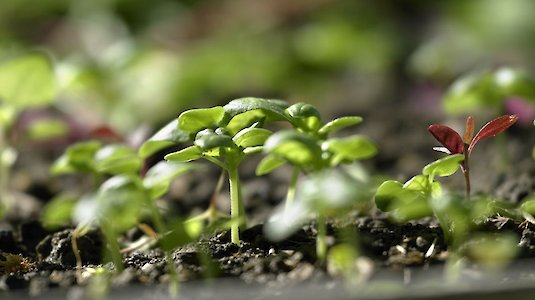Early start in the vegetable patch
Fancy fresh peppers and tomatoes from the garden or balcony? What to do to enjoy these delicacies from our own cultivation? If we want to enjoy these delicacies from our own cultivation, we have to be patient a little longer. But now we lay the foundation for the harvest in early spring by producing some vegetables in the house.
Melanzani, peppers and other thermophilic vegetables come from tropical or subtropical regions. In order for these southern plants to produce yield in our country, they need a starting period under glass - just like early varieties of salads, certain cabbages or vegetables with a long development time.
More variety in your own garden
Professional gardeners who take the trouble to grow their vegetables themselves from the seed look out for seeds of particularly tasty and rare varieties that are suited to the local climate. Organizations like "Arche Noah" in Schiltern (Lower Austria) see it as their big goal to preserve the diversity of cultivated plants. there you can find a huge selection of different tomatoes and other vegetables, which can be ordered as seeds or purchased at plant exchange markets.
Sowing: the right time
Early cabbage, cauliflower, peppers, chillies, lettuce, tomatoes, kohlrabi and aubergines can be sown until March. For pumpkin and zucchini April is sufficient.
Suitable soil as the most important basis
Plants need different mixtures of soil, depending on the variety but also on the stage of development. To ensure that the pre-breeding really succeeds, there are special, unfertilized growing media. Most seedlings react very sensitively to the fertilising salts contained in conventional garden soil. Cultivation soils without peat are available in specialist shops. Sowing soils with the Austrian Ecolabel (for instance from the Lower Austrian company Naturrein Biogarten GmbH) are available in nurseries, specialist shops and organic shops as well as from garden markets.
But you can also produce your own growing soils easily. For this, you mixe mature, sieved and steamed compost or garden soil with 1/3 sand and 1/3 coconut fibres or peat substitute. The rule of thumb is to cover the seeds with a layer of soil corresponding to their thickness.
Avoiding diseases
Seedlings thrive optimally if the seeds are briefly placed in herbal baths before sowing. The silicon contained in common horsetail is incorporated into the cell walls of the seedlings, making it more difficult for harmful fungi to penetrate the roots. It is also important for disease prophylaxis to rinse the sowing shells of previous seasons with hot water to kill germs.
Care and location
The seed trays are best kept in a bright room at room temperature. However, direct sunlight on the seed trays should be avoided. With a transparent glass or plastic cover you can ensure optimum air humidity and ideal germination conditions. As soon as the first leaves emerge from the ground, remove the cover and place the plants in the east or west window of a cool but bright room at a maximum of 18°C to achieve compact growth. If the plants are too warm, they will form long stems (harden) and eventually fall over.
As soon as the first pair of leaves appears next to the cotyledons, the plants are separated in piercing trays or pots with nutrient-rich soil.
In order to accustom the plants to the harsher outdoor conditions, the young plants are placed in the cold frame in the 2nd half of March, which is aerated during the day in mild weather and closed at night. Small mobile greenhouses, which can be pushed from the balcony into the house in frosty weather, serve the same purpose.
In view of the coming garden joys in the summer, die-hard home gardeners are happy to take on these efforts.
Our garden brochure "feel-good oasis" will tell you more!
